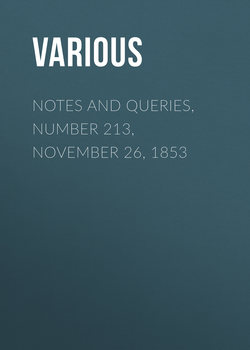Читать книгу Notes and Queries, Number 213, November 26, 1853 - Various - Страница 8
Minor Queries
ОглавлениеMonumental Brass at Wanlip, Co. Leicester, and Sepulchral Inscriptions in English.—In the church of Wanlip, near this town, is a fine brass of a knight and his lady, and round the margin the following inscription, divided at the corners of the slab by the Evangelistic symbols:
"Here lyes Thomas Walssh, Knyght, lorde of Anlep, and dame Kat'ine his Wyfe, whiche in yer tyme made the Kirke of Anlep, and halud the Kirkyerd first, in Wirchip of God, and of oure lady, and seynt Nicholas, that God haue yer soules and mercy, Anno Dni millmo CCCmo nonagesimo tercio."
Mr. Bloom states, in his Mon. Arch. of Great Britain, p. 210., that—
"There are, perhaps, no sepulchral inscriptions in that tongue (English) prior to the fifteenth century; yet at almost the beginning of it, some are to be met with, and they became more common as the century drew to a close."
Is there any monumental inscription in English, earlier than the above curious one, known to any of your correspondents?
William Kelly.
Leicester.
Influence of Politics on Fashion.—Can any one of the numerous readers of "N. & Q." explain the meaning of the following passage of the note of p. 305. of Alison's History of Europe, 7th edition?—
"A very curious work might be written on the influence of political events and ideas on the prevailing fashions both for men and women; there is always a certain analogy between them. Witness the shepherd-plaid trousers for gentlemen, and coarse shawls and muslins worn by ladies in Great Britain during the Reform fervour of 1832-4."
Henri van Laun.
King William's College, Isle of Man.
Rev. W. Rondall.—Can any of your correspondents give information respecting the Rev. William Rondall, Vicar of Blackhampton, Devonshire (1548), who translated into English a portion of the writings of the learned Erasmus?
Historicus.
Henry, third Earl of Northumberland.—The above nobleman fell on the battle field of Towton (Yorkshire), 29th March, 1461, and was interred in the church of St. Denys, or Dionisius, in York, where his tomb, denuded of its brass, is still pointed out. Pray does an account exist, in any of our old historians, as to the removal of the body of the above nobleman from that dread field of slaughter to his mansion in Walmgate in the above city, and of his interment, which doubtless was a strictly private one? Again, does any record exist of the latter event in any book of early registers belonging to the above church? Doubtless many readers of "N. & Q." will be able to answer these three Queries.
M. Aislabie Denham.
Piersebridge, Darlington.
"When we survey," &c.—Where are the following lines to be found?
"When we survey yon circling orbs on high,
Say, do they only grace the spangled sky?
Have they no influence, no function given
To execute the awful will of Heaven?
Is there no sympathy pervading all
Between the planets and this earthly ball?
No tactile intercourse from pole to pole,
Between the ambient and the human soul?
No link extended through the vast profound,
Combining all above, below, around?"
Alledius.
Turnbull's Continuation of Robertson.—Some years ago, a continuation of Robertson's work on Scottish Peerages was announced by Mr. Turnbull, Advocate of Edinburgh.—I shall be glad to be informed whether it as published; and by whom or where.
Fecialis.
An Heraldic Query.—Will any one of your contributors from Lancashire or Cheshire, who may have access to ancient ordinaries of arms, whether in print or in manuscript, favour me by saying whether he has ever met with the following coat: Per pale, argent and sable, a fess embattled, between three falcons counterchanged, belled or? It has been attributed to the family of Thompson of Lancashire, by Captain Booth of Stockport, and an heraldic writer named Saunders; but what authority attaches to either I am not aware. Is it mentioned in Corry's Lancashire?
Heraldicus.
Osborn filius Herfasti.
